This was published 6 years ago
Food and wine in Alentejo, Portugal: There is no such thing as a short lunch in this region
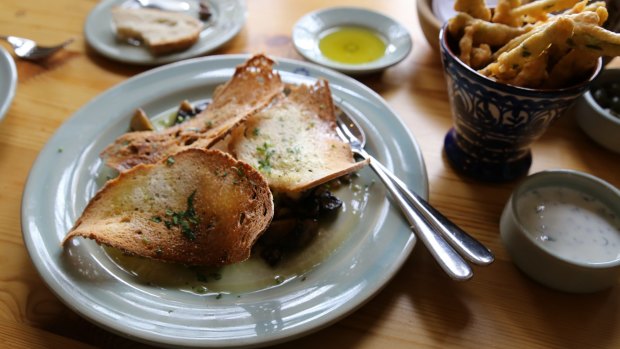
Wild mushrooms with local bread at the boutique hotel Sao Lourenco do Barrocal, in the Alentejo.Credit: Ben Groundwater
Libanio pushes his empty plate forward, reaches for the wine bottle in the centre of the table and tops up our glasses. He then sighs a sigh of deep satisfaction as he leans back and settles his hands on his stomach. "There's no such thing," he smiles, "as a short lunch."
He's right. Around here, at least, there is no such thing as a short lunch. Not one that I've witnessed, anyway. Lunch isn't just a meal in this part of Portugal, it's a daily celebration. It's an opportunity to pause for a few hours and pay homage to all that's good about the world at that particular moment: to good food, to good wine, to good company. Why would you want to cut that short?
Today, it appears we won't. We've just finished our main courses: pork cheeks stewed in red wine; braised wild boar served with roasted, mashed chestnuts; deep-fried green beans with herbed yoghurt. Those dishes followed our starters: fresh-baked bread with local olive oil; wild mushrooms sauteed and served with a single, perfect poached egg; veal carpaccio with rocket and local sheep's milk cheese.
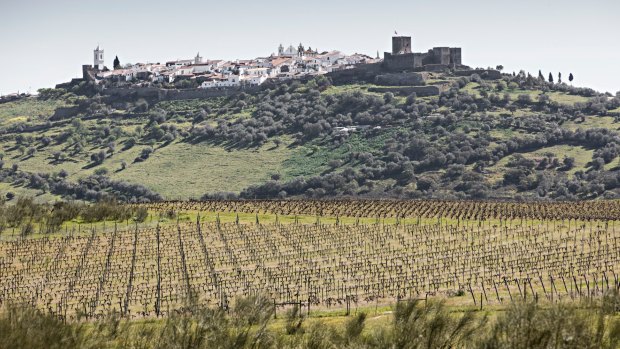
Views across Alentejo's vineyards to the fort town of Monsaraz.
And as Libanio refills our wine, we're staring down the barrel of a large dessert: a cheese pudding with pumpkin jam, plus a honey and walnut cake and some seasonal fruit. Then we'll have a coffee, then we'll polish off the wine, and then we'll stagger out of here and get back to the business of touristing.
The restaurant is at Sao Lourenco do Barrocal, a winery and boutique hotel that sits in the shadow of Monsaraz, one of the many medieval fort towns that dot the hilltops in this part of Portugal. The food here is all local, and the source of much pride. The olive oil is produced on the premises at Sao Lourenco. The wine, too, is fermented, barrelled and bottled a few hundred metres away, on the property. The pork comes from the black-footed Iberian pigs for which this region, the Alentejo, is famous. The chestnuts are a seasonal delicacy.
In fact the entire menu here is strictly from Alentejo: it's a snapshot of local culture, a gastronomic diorama of all that's traditional and fiercely cherished in this area. And that is food.
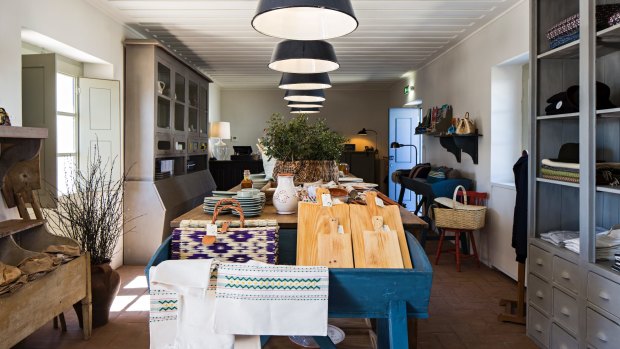
The farm shop at Sao Lourenco do Barrocal, a winery and boutique hotel, sells local artisanal products.
You only have to gaze around you here to know immediately what's on offer. The Alentejo is the largest region in Portugal, an area that covers almost a third of the country, and it's all about agriculture. The country's capital, Lisbon, might be only a few hours' drive to the west, but here it's all open fields and small villages, with a pace that you can very easily get used to.
Not much happens in Alentejo. It's not wildly popular as a tourist destination, not in the way it is to the south in beachy Algarve, or north in the famous Douro Valley. The sights here aren't well known; the allure is more refined.
There's a glorious idyll to Alentejo, a feeling not merely that time has slowed down, but that it might just have stopped. There are so few cars on the road; so few people in the towns. Houses look the way they have for centuries, whitewashed with flourishes of yellow. Church spires are the highest points on the skylines. It's hard to tell sometimes if the medieval hilltop towns are actually inhabited, or if they were ruined long ago.
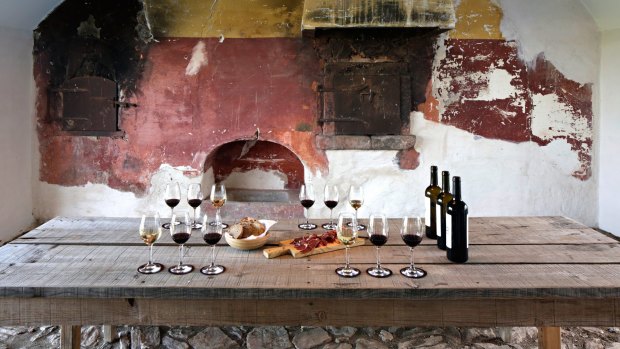
Wine tasting by the old wood-fired oven at Sao Lourenco do Barrocal.
From the viewpoints of those citadels, however, you get to see the true pride of the Alentejo laid out before you: the grassy golden plains, where cows and sheep and pigs graze; the forests of cork trees and the vast olive groves; the rows of grape vines that stretch out to the horizon. So much of Portugal's best food and wine is produced here.
You quickly discover that while there's no such thing as a short lunch in Alentejo, there's also no real sense of hurry to any meal. Libanio and I have been strolling the cobbled streets of the Alentejan capital, Evora, for about an hour before he suggests a coffee break. I agree, and so we duck into a small cafe, one of seemingly thousands that line the streets here, and order the region's favourite morning treats: tartes de amendoa, or almond meal tarts, along with classic Portuguese custard tarts and strong black coffee.
We sit back to savour the mini-meal with the relish it deserves. Yes, there are attractions out there we could be seeing. There's a beautifully preserved Roman temple in Evora, completely free of the tourist crush you'd expect at such a sight. There's a cathedral with a basement chapel filled with human bones. But Evora is best enjoyed as Evora's citizens do: with a pause for coffee and cake, to chat with friends, to enjoy the treacle-like passage of time.
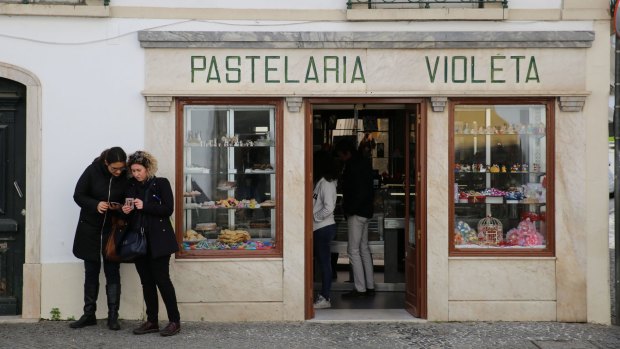
Cake shop in Evora.Credit: Ben Groundwater
Sightseeing around here, after all, is more a chance to seek out the Alentejo's gastronomic specialties than it is to discover its classic tourist attractions. There's so much to eat and enjoy. That's what's special.
There's meat from the black-footed Iberian pig, an animal made famous by the Spanish across the border in Andalucia and Extremadura with their jamon iberico; though according to the Portuguese, their version is just as good. Maybe better.
Olive oil, too, is highly prized here. It's grown and pressed often by small family outfits or cooperatives of local farmers. You see it sold in the local delis, or served up in restaurants with crusty bread; always an intense dark green, nutty and strong. Alentejo cheeses are similarly cherished, and creep onto most menus.
And then there's Alentejo wine, perhaps the source of the most local pride. Alentejo has a DOC classification, and there are eight subregions within that each produce distinctive drops. You'll find these wines sold and drunk across Portugal, but nowhere are they more highly prized than in the region itself.
And we can see that at Sao Lourenco, a boutique winery in the Reguengos subregion, a Luxury Small Hotel of the World that also happens to do an excellent line in some of Portugal's signature grapes, the likes of Aragonez, Alicante Bouschet and Touriga Nacional. The wine here is matured on site in concrete stills, the old way, the way wines have been made in this area for centuries.
It seems only right for Libanio and me to sit around at the Sao Lourenco restaurant and savour the wine, savour the food, savour the views of the golden plains and the rows of grape vines and the hilltop village and everything else that's so great about Alentejo, and just enjoy the slow passage of time. There's no such thing as a short lunch here – but why should there be?
TRIP NOTES
MORE
traveller.com.au/portugal
visitalentejo.pt
FLY
Emirates flies from all major Australian ports to Lisbon, via Dubai. For bookings, see emirates.com, or call 1300 303 777. Trains run regularly between Lisbon and Evora. For timetables see cp.pt. Alternatively, car hire is available through europcar.com.
STAY
Sao Lourenco do Barrocal has beautiful accommodation at its boutique winery, with rooms that range from regular doubles, to two and three-bedroom cottages, all in stylishly renovated former farmhouses. See barrocal.pt for bookings, as well as information on the restaurant, and wine.
Ben Groundwater travelled with assistance from Emirates Airline and Turismo de Portugal.
FIVE PLACES TO VISIT IN ALENTEJO
Monsaraz
This one-time strategic fortress, the scene of several major battles between the Christians and the Moors, and a stronghold of the Knights Templar, is these days a peaceful little village that sits atop a mountain in eastern Alentejo. There are no cars in Monsaraz, just narrow pedestrian streets and small shops run by local artisans.
Evora
The Alentejo capital is home to some of the region's best restaurants, including O Fialho, which does an excellent range of traditional dishes, and Tasquinha do Oliveira, an intimate spot run by a husband-and-wife team. The city is also completely encircled by Roman and Middle Ages-era walls, and has a 2000-year-old Roman temple.
Beja
Beja is like a smaller, more intimate version of Evora, a friendly place with a walled old town, some excellent cafes and restaurants, a Franciscan convent that dates back to 1459, and an old church – the Igreja de Nossa Senhora dos Prazeres – that doubles as an impressive art gallery.
Almendres Cromlech
To the untrained eye, these Megalithic ruins outside the town of Evora just look like rocks sticking haphazardly out of the ground. With a bit more investigation, however, you discover there's a pattern to the 95 granite monoliths that were placed here about 7000 years ago. Some of the rocks also have carvings, marks made by a long-lost people.
Castelo de Vide
This is the postcard hilltop town you've been searching for. The houses in Castelo de Vide are all whitewashed, under terracotta roofs; the castle from which the town takes its name dates back to 1280, and can still be explored today; and of course, the views, out towards the Spanish border, are stunning.
Sign up for the Traveller Deals newsletter
Get exclusive travel deals delivered straight to your inbox. Sign up now.